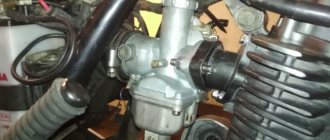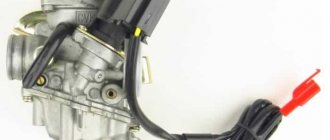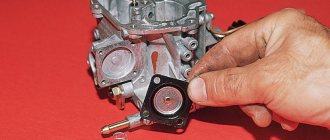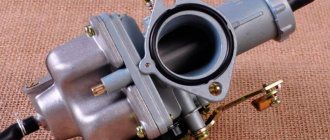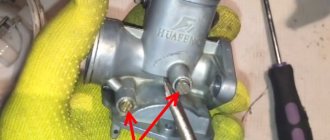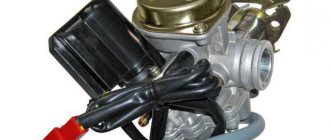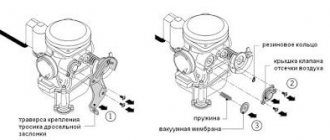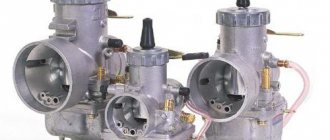In the conditions of mass production of internal combustion engines, it is impossible to ensure perfect manufacturing accuracy; as a result, engines coming off the same assembly line may differ from each other within certain limits. The same situation occurs with the production of engine fuel system elements, in our case, carburetors.
The matter is further complicated by the fact that initially the engine manufacturer does not know in what climatic conditions a specific engine model will be operated. As you know, the same engine will operate completely differently in different climatic conditions.
Designers designing engines are well aware of these problems and therefore introduce adjusting elements into the power system (in our case, the carburetor), by influencing which you can significantly improve the efficiency, power and dynamic performance of your scooter’s engine based on specific operating conditions.
First, a little theory.
As you know, a carburetor is a device in which the working mixture (a mixture of air and gasoline) is prepared, without which the operation of the internal combustion engine is impossible. The most optimal ratio of gasoline and air in the working mixture is the value: 1/15, that is, for 15 kilograms of air there is 1 kilogram of gasoline. With such a mixture, the engine will operate without interruptions and detonation. This mixture is usually called optimal.
Unfortunately, at the optimal mixture, the scooter engine in some modes will not be able to operate stably, for example: in cold start mode, for stable operation the engine requires a mixture in which there is slightly less air than in the optimal mixture, the ratio of such a mixture is: 1/13, that is For every 13 kilograms of air there is 1 kilogram of gasoline. This mixture is usually called “rich”.
In order to enrich the mixture at the right time, additional modules (starting enrichers) are introduced into the carburetors, which are essentially mini carburetors; more details about the operation of the starting enricher are written in the article: Automatic starting enricher for a scooter
The most dangerous for engine operation is considered to be a lean mixture (a combination of gasoline and air of approximately 1/17 or lower. When the engine operates on such a mixture, detonation occurs and overall engine overheating, which ultimately leads to burnout of the piston or cylinder head gasket, melting of the internal surface of the cylinder head, such “little things” as burnout of the exhaust valve need not be mentioned at all.
We place the scooter on the central stand, provide free access to the carburetor adjustment elements, and warm up the engine (a prerequisite for high-quality carburetor adjustment).
We begin the process of setting up the carburetor by adjusting the idle speed. For this purpose, there is a special bolt on any carburetor (marked with an arrow), by rotating which you can increase or decrease the idle speed. By rotating the idle speed bolt, we achieve minimum, but at the same time stable engine speed.
After adjusting the idle speed, we proceed to adjusting the quality of the mixture. For this purpose, the carburetor has a mixture quality bolt (marked with an arrow), by rotating which you can change the composition of the mixture within certain limits. On different models of carburetors, the “quality” screw works on a different principle: in one case, the “quality” screw closes the air channel of the idle system, thereby reducing or increasing the amount of air in the mixture (enriches or leans it), in another case, the “quality” screw regulates the amount of ready-made mixture (emulsion) entering through a special channel into the engine intake manifold.
In general, there is no particular difference between the two principles of operation of a “quality” bolt, except that in the first case, when tightening the screw, the mixture becomes richer, and in the second, when tightening the “quality” screw, the mixture becomes leaner, keep this point in mind.
We determine the correctness of adjusting the quality of the mixture as follows: after adjusting the quality bolt, we give sharply full “gas” (preferably while driving), the engine should confidently develop speed without jerking delays and detonation, a pronounced “catch” should be felt. If the engine unsteadily picks up speed, detonates or stalls when the throttle is suddenly closed, then you should once again adjust the position of the quality screw until the engine begins to develop speed with a pronounced “catch”.
If, after adjusting the quality screw, it is still not possible to achieve normal operation from the engine, then we try to lower or raise the carburetor needle in increments. If the engine picks up speed poorly (rich mixture), lower the needle; if the engine picks up speed unsteadily, detonates and stalls when the throttle is closed abruptly, raise the needle. Try to raise and lower the needle one division at a time and not immediately all the way up or down.
You can read more about the structure and adjustment of the needle in the article: Photo report: Design of the carburetor of a four-stroke scooter (carburetor 4t) or in the article: Photo report: Disassembly and design of the carburetor of a two-stroke scooter (carburetor 2t).
Next, after all that has been done, we drive the scooter for several kilometers as usual, unscrew the spark plug and visually determine by the color of the spark plug insulator what mixture the carburetor is “preparing.”
If the spark plug insulator is black and covered with a layer of soot, then the carburetor is “preparing” a “rich” mixture, in this case the situation can be corrected by lowering the carburetor needle to the desired division.
If the spark plug insulator is snow-white, it means the carburetor is “preparing” a “lean” mixture, in this case the situation can be corrected by raising the carburetor needle to the required division.
If the spark plug insulator is sand or brick-colored, then your carburetor is preparing the optimal mixture and no further adjustment is necessary.
After the final adjustment of the carburetor, you should adjust the free play of the throttle cable; for this purpose, there is a special nut on the cable by tightening or tightening which you can reduce or increase the free play of the cable. The free play of the throttle cable should be: 1-2 mm.
On some models of scooters equipped with 2T engines, after final adjustment of the carburetor, the positions of the oil supply control drive should be adjusted. To do this, just like in the first case, we look for the adjusting nut on the oil supply system drive cable and tighten and release the nut until the marks (marked by arrows) are opposite each other.
Adjusting the carburetor on a 2t scooter: setting it up together
We continue to discuss DIY motorcycle repairs.
The carburetor has been cleaned, the next step is to adjust the carburetor of the 2t scooter. Over the summer, you have to adjust and adjust the operation of the engine several times.
Anyone who is at least a little familiar with the structure of the carburetor will be able to set it up on their equipment themselves. On 2-stroke engines, carburetors are adjusted according to the same principle. Therefore, the topic will be of interest to owners of any brand of 2t 50cc scooters. Whether you have a Honda Dio 27, 34, 35, stroke, Yamaha Jog, BVS or other 2-stroke mopeds.
Diagnostics
Before installing the air filter, turn on the ignition and jerk the kickstarter foot several times until the engine starts.
If it does not start, then the most common reason is that the cold start system is malfunctioning.
We check this way: cover the carburetor hole with your fingers to maximally enrich the mixture with gasoline, and continue to push the kickstarter.
If the engine starts and the speed does not drop during operation, then look for the reason in the cold start system.
If the cold start system is working properly, then after starting the engine the speed will rise and gradually, within 10 minutes, begin to fall. On a warm engine, gradually unscrew the large screw (amount of mixture) until the speed drops to medium, confident idle.
At the same time, drops of gasoline should not splash or pour out of the carburetor.
If gasoline splashes out of the air supply hole, this indicates a malfunction of the reed valve in the engine. Then the valve needs to be removed and cleaned or replaced with a new one.
And if gasoline leaks out, this indicates a high level of gasoline. Adjust the float level and ensure the needle valve is sealed.
Moscow Scooter Club
Forum rules MUST indicate the model, unit and symptoms of the malfunction in the topic title.
Heading form: [SCOOTER MODEL] - unit malfunction Example: [Dio] electric starter does not work.
If the topic concerns general repair issues, the model may not be specified.
The main rule is that the title of the topic should be brief, but as fully as possible reflect its content. Topics whose title does not indicate at least the approximate essence of the question, such as “AAA. Save!”, “I have a problem, tell me,” will be DELETED.
Stels Skif - 50. Problems with youth.
Georgiy » 02 Jun 2009 15:33
Vehicle: Chinese-Russian two-stroke Stels Skif - 50. Mileage: 170 km
Story 1: I filled a full tank of 95 twice, the last time with oil (for the sake of “breaking in”, plus 50 grams of oil in the gas tank in addition to the oil in the oil tank). Soon the engine began to lose power and stall even when warmed up. I asked the “experienced” in the garages, they advised “to drive around our gas station a kilometer away, there’s a lot of gas there.” I drained the gasoline, filled the TNK with a full tank, and injected carburetor cleaner into it. I revved it up and drove around. The symptoms have changed: now it works normally at idle, does not stall, and when the throttle is turned on, terrible dips appear (after 20 km/h). It’s as if either the spark plug is working intermittently (I unscrewed the spark plug and cleaned it), or gasoline is flowing intermittently to the carburetor. Also, if the scooter just sits there for a while, it starts up easily and works fine for several minutes without any failures. and then a new one (as if gasoline was simply not being supplied, like the gas filter was clogged). Who knows what's wrong?
Story 2: After 100 km of run, play in the fork appeared. The wording may not be correct, but the gist is this: Hold the front brake and push the scooter back and forth. As a result, you can see how the wheel moves back and forth by several millimeters relative to the steering wheel. I contacted the scooter service at the intersection of the Moscow Ring Road and Varshavka (under warranty), they said that all SKIFs are like this, like a design feature that cannot be eliminated. I didn’t believe it, I went to their hall and poked at 2 new SKIFs that had just been assembled. Yes, everyone has such a backlash. Question - how to fix the backlash?
KSBes » 02 Jun 2009 16:35
Georgiy » 02 Jun 2009 16:39
Pashtet06 » 03 Jun 2009 22:44
Georgiy » 04 Jun 2009 12:17
Stop guys. As for the 1st story, everything turned out to be simpler. Damn, I just don’t understand what’s wrong, but I changed the spark plug and everything fell into place. Cleaning the old candle apparently didn’t help (although it wasn’t dirty at all), probably it worked “for breakdown”. Perhaps they just stuck a defective one.
Thanks everyone, topic closed!
belka-letyaga » 05 Jun 2009 10:40
that's for sure, the candle in the scooter is an on-board computer and a recorder.
As for stealth, I can’t say anything bad. Unless the nuts and bolts are not tightened well, it needs to be checked. I haven’t encountered any problems with the chassis engine.
Georgiy » Jun 30, 2009 11:25
KSBes, you're damn wrong. Replacing the fork has nothing to do with it. The warranty service center is also a bitch, like “this is a design feature. "No matter how it is. I removed the “face”, tightened 2 nuts on the steering shaft and the play disappeared.
By the way, guys, I warn you: do not rely on the guarantee at the “scooter market” (metro Annino). They do nothing under warranty, the catchphrase is: “this is a design feature, it cannot be treated.” But in fact, even with my inexperienced hands, everything can be treated perfectly!
omsound » Sep 15, 2009 11:50 am
Georgiy wrote: KSBes, you're damn wrong. Replacing the fork has nothing to do with it. The warranty service center is also a bitch, like “this is a design feature. "No matter how it is. I removed the “face”, tightened 2 nuts on the steering shaft and the play disappeared.
Methods for adjusting and tuning a scooter carburetor
The carburetor is an important part, without which the engine will not work. How to set up the carburetor on a scooter determines how smoothly and correctly the engine will run and whether it will be possible to start it in cold weather. The task of this unit is to mix gasoline with air in certain proportions, resulting in the formation of a working mixture, the composition of which determines the behavior of the power unit. The standard ratio should be 1 to 15, if you need the scooter to idle well, you can lean the mixture a little by making 1 to 13; enriched mixture - 1 to 17. For a more in-depth study of the design of a scooter carburetor, we recommend reading the article “The design of a scooter carburetor and the principle of its operation.” Well, now let's learn everything about adjusting the 2-stroke and 4-stroke carburetor of a scooter.
Review of the STELS Tactic 50 scooter
Of course, the STELS Tactic 50 scooter will also be appreciated by representatives of the older generation. It has quite adult dimensions and good technical characteristics, which will certainly attract the attention of all lovers of motorized two-wheeled vehicles. However, a motor scooter is especially attractive as a gift for a child. A scooter is a wonderful gift that encourages a teenager to be more attentive, responsible, and can also satisfy and stimulate a craving for technology.
Unlike its predecessor Skif 50, in the Velomotors scooter line, the STELS Tactic 50 is equipped with a more powerful engine: the maximum power of 2.9 horsepower at 5500 rpm is 60% higher than that of the Skif 50, and the maximum torque is 3. 5 rpm In addition, the STELS Tactic 50 has large dimensions - 1.8 x 0.7 x 1.1 m, the saddle height is 75 cm, and the wheelbase is 1.27 m. The manufacturer has equipped the scooter with wider tires: the front and rear tires have width 120 and 130 mm respectively. In general, the scooter was more powerful, larger and heavier (92 kg).
Otherwise, the scooter has standard characteristics: carburetor power system, contactless ignition system with CDI electronic control, CVT transmission, two-stage spur gearbox, front disc and rear drum brakes, automatic gear shift mode. The maximum speed is 55 km/h. In general, the two-wheeled vehicle combines reliability and excellent driving characteristics, which allow you to plan trips over long distances. A luggage rack for small items is included.
We should also highlight the nice design and electronic components. The scooter's dashboard has an LCD monitor that displays traffic information, including missed calls and received cell phone text messages. A very relevant function for young people who want to always stay in touch. You can add the included sports muffler to the design treasury, and in favor of electronics, you can add an alarm system to control the engine start from a distance.
Trips to the sea, moving around the city, to a suburban dacha - for all this the STELS Tactic 50 is perfect. You can be sure that your children will also enjoy the versatile features of this scooter.
How to adjust the carburetor on a scooter
Knowing how to adjust the carburetor on a scooter, you can get rid of many problems, make sure that the vehicle starts immediately, runs smoothly and does not fail in hot or cold weather. For this, the carburetor, depending on the model, has either only a needle or special adjusting screws.
Adjusting the carburetor on a scooter, if there are adjusting screws, occurs as follows: when the screw is rotated clockwise, the mixture becomes richer, and counterclockwise, accordingly, it becomes leaner.
The procedure must be carried out in the following order:
You also need to take into account little things that may be present on some scooter models, but not on others. For example, before adjusting the carburetor, you need to check the condition of the fuel filter. If it is very dirty, it is recommended to replace it, since even if the carburetor is new and well tuned, a clogged filter will prevent the mixture from flowing in the correct proportion.
The question of how to adjust the carburetor if you have the popular Japanese scooter Honda Dio is quite relevant. Regardless of the year of manufacture and type of carburetor, the scheme described above will suit it.
Idle speed adjustment
Idle speed adjustment plays an important role. When the engine warms up well, you can begin this procedure. To do this, you will need to rotate the adjusting screw clockwise. Its location depends on what model of scooter and carburetor you have. If you don’t know the exact location, find the description instructions for the installed model, where it will be written where which screw is located. For example, on a Honda, the original carburetor has such a screw in the center; on the left side you can find an adjustment for the quality of the mixture.
Adjustment is not difficult: you need to do it with the engine warm and running. When you tighten the screw, the speed will increase, and when you unscrew it, it will decrease. When the engine runs smoothly, you need to stop rotating the propeller. This must be done smoothly, after each change in position, let the engine run a little
Adjusting the mixture quality
Depending on the position of the needle in the carburetor, the percentage of gasoline and oxygen also changes: if there is a lot of air in the mixture, this can be seen by the spark plugs. They will turn black and a characteristic soot will appear. If, on the contrary, there is not enough air, a white coating appears on the candle, and it is clear that the electrode is melting. And this. and that’s not very good for the engine as a whole, not to mention the fact that you will have to change the spark plugs often. Before tuning, you need to unscrew the spark plug and examine its condition, from which you can already build on it, enriching or leaning the mixture.
Not only the operation of the engine, but also its condition depends on the quality of the mixture. For example, with a lean mixture, traction disappears, and with an excessively rich mixture, carbon deposits gradually form in the combustion chamber, which harms the engine. If the carburetor is modern, it has a special screw for adjusting the quality of the mixture, so there is no need to disassemble it. In order to enrich the mixture, the screw must be rotated clockwise; to lean it, rotate it counterclockwise.
The adjustment occurs as follows:
If the carburetor model is old or the screw is missing, in order to debug its operation, you need to get to the needle. In this case, adjustment of the scooter carburetor occurs as follows: there is a special locking ring on the needle. When you raise it up, the mixture will become richer, and when you lower it down, it will become leaner. Typically from the factory the retaining ring is in the middle. Having pulled out the needle with your fingers or tweezers, we move the ring and reassemble the carburetor. After this, you can start the engine and see how it works. If necessary, adjust the settings to perfection using adjustment screws.
Adjusting the fuel level in the float chamber
The fuel level in the float chamber plays an important role. This part is located inside the carburetor, where the process of mixing gasoline with air takes place. In addition to the free reservoir, it contains a float, jets and a needle valve. It is the position of the float that determines when the valve is closed and, accordingly, whether the carburetor will overflow or not. If there is too much gasoline, the engine will start to stall because the spark plug will get wet and the spark will not be able to ignite the mixture.
The reasons why the carburetor on a scooter overflows are usually the following:
The first two problems can be solved by cleaning the carburetor. You cannot use metal objects for this; You can arm yourself with a soft rag. Particular care should be taken when handling jets. The inside can be cleaned with a thin copper wire, but this should be done carefully. The second problem is solved by bending the tongue. It is quite fragile, so you can use your fingernail or tweezers, being careful not to break it. It is easy to check whether the float is positioned correctly: it should be parallel to the body, and not tilt up or down. Then, when fuel enters the chamber in the required amount, the float will rise, and the valve will block the flow of excess fuel into the chamber. Why a scooter carburetor overflows can be found in more detail here.
How to adjust the float in the float chamber on a scooter?
To do this, you need to use a nozzle: it is located at the bottom of the chamber. The screw must be unscrewed, but in such a way as to prevent gasoline from leaving the tube. Usually it is located below the nozzle; if the tube is transparent, it will be more convenient to carry out the work. In order to see the fuel level, it must be raised vertically.
At a normal fuel level, gasoline does not reach the curb of the carburetor cover, at a higher level it begins to overflow, at a lower level the scooter rides poorly and nods. To adjust, you will need to disassemble the carburetor, find the needle inside the float chamber, there is a locking ring on the needle, it needs to be moved down.
Carburetor 2T Stels Tactic50, Vortex50, Patron Shark
The personal information you provide (name, address, telephone, e-mail, credit card number) is confidential and will not be disclosed. Your credit card information is transmitted only in encrypted form and is not stored on our Web server.
The security of processing Internet payments using plastic cards is guaranteed by the acquiring bank. All card transactions occur in accordance with the requirements of VISA International, MasterCard and other payment systems. When transmitting information, special security technologies for online card payments are used; data processing is carried out on a secure high-tech processing server.
If you have questions about the confidentiality of transactions with payment cards and the information you provide, you can contact the bank's technical support service.
On the authorization page you will need to enter the card number, cardholder name, card expiration date, card verification number (CVV2 for VISA or CVC2 for MasterCard). All necessary data is printed on the card itself. The card verification number is three digits located on the back of the card.
To pay, you will be redirected to the bank page.
Payment must be made within 15 minutes after going to the card authorization page.
The transaction may take approximately 40 seconds. Wait for the operation to complete. Do not click the "Pay" button again.
Payment occurs in real time and is credited within 15 minutes.
We accept cards of payment systems: VISA, Mastercard, MIR. The connection to the payment gateway and the transfer of information is carried out in a secure mode using the SSL encryption protocol. If your bank supports the Verified By Visa or MasterCard Secure Code technology for secure online payments, you may also need to enter a special password to make a payment. You can check the methods and possibility of obtaining passwords for making online payments with the bank that issued the card. The confidentiality of the reported personal information is ensured by Sberbank PJSC. The entered information will not be provided to third parties except in cases provided for by the legislation of the Russian Federation. Payments by bank cards are carried out in strict accordance with the requirements of Visa Int payment systems. and MasterCard Europe Sprl.
Delivery
If the overall size of the shipment does not allow it to be sent in one parcel, the order, as agreed with the client, is divided into the number of parcels required for shipment. In this case, the delivery cost is calculated separately for each parcel.
The cost and delivery time depend on the region, price and weight of the order. You need to enter the city name or postal code when placing your order, the system will automatically calculate the cost and estimated delivery time. Please note that the actual delivery time is usually 1-2 days longer. You can find out all the information related to the delivery and payment of goods by calling: +7 (995) 343-7400.
In accordance with Article No. 497 of the Civil Code of the Russian Federation, clause 4, in the event of refusal of goods of proper quality upon delivery, the buyer is obliged to reimburse the seller for the costs incurred from completing the order (i.e., pay for delivery).
Delivery for legal entities in Russian regions
Delivery of goods to regions of Russia is carried out by courier service. At the time of delivery, primary documents are provided, which are included in the box with the goods. To receive the goods, a representative of the company that paid for the goods must issue an invoice (sign and stamp it or provide a power of attorney in the M2a form, which is attached to the invoice) and return it back to the supplier of the goods.
Exchange or return of goods
The risk of accidental loss or damage to the goods passes to the buyer from the moment the goods are transferred. After the courier leaves, claims regarding appearance and packaging will not be accepted . After handing over the goods to the consumer, the return is made within seven days (Article 26, clause 4 of the PZPP).
To return or exchange goods of proper quality, the buyer independently and at his own expense sends the goods to our address by any transport company. Refunds are made after we receive the goods back to the card or bank account (depending on how the goods were paid for by the buyer). When returning or exchanging a defective product, we pay for shipping.
Return of goods of proper quality is possible if they are preserved:
- presentation - full compliance of the product with the form in which the manufacturer supplies the product to the retail chain for its further sale, in particular, this means that the packaging of both the product as a whole and its individual parts should not be damaged; The product must contain stickers and other brand symbols installed by the manufacturer (seller)
- complete set of the product, its accessories, as well as documents related to the product (technical passport, operating instructions, etc.)
- consumer properties
- a document confirming the fact and conditions of purchase of the goods
- there is an application for return or exchange
Features of setting up the carburetor of a 2-stroke scooter
The carburetor on the 2t scooter is slightly different in design and does not fit the 4t motor. The question of how to set up such a device worries all owners of two-stroke machines.
Most Chinese models have a fairly simple carburetor without unnecessary adjustments. The enrichment here is mechanical, although if you are tuning a scooter or you have a Japanese model, the enrichment can also be electric. In order to use the mechanical option, you must first pull the trigger on it, and then try to start the equipment.
Adjusting the carburetor of a 2T scooter is not difficult, but it does require some patience. In order to do this, you will need to disassemble the carburetor: first you will need to unscrew the top cover. The needle in it is fixed with a staple; it needs to be pulled out. The quality of the mixture is adjusted in the same way as described above. A feature of the push-pull system is that the needle affects the quality of the mixture only in a certain position. If the throttle valve is raised to its maximum, only the main fuel jet will be responsible for the fuel mixture. Sometimes the idle speed system interferes with it. Depending on what carburetor you have installed.
For a cold start, you need to use a starting enrichment, which must be closed after the engine warms up; Simply put, it's a suction. In such carburetors, the fuel level plays an important role. It is also regulated by mechanical intervention in the operation of the float chamber. It is configured in the same way as in the four-stroke version. In fact, the carburetor for 2t engines differs from models for engines on a 4-stroke scooter only in jets and some other parameters, but it is designed similarly, and therefore is regulated in the same way.
Stealth Tactic 50: cheaper only on foot
Motorcycles in the most budget category will always be popular and in demand. The lightweight Stels Tactic 50 scooter is an excellent example of this; due to its low price, it was produced for many years.
The Stealth Tactic 50 scooter did not shine with impressive technical characteristics, catchy design or other advantages even at the moment when it first went on sale. Why did he become so popular? It's simple - dealers offered it at a very low price , and this attracted a large number of thrifty buyers for whom the cost of purchase and maintenance is of paramount importance. Over the past years, tens of thousands of copies of this model have been sold, and many of them are still in use, because there are no problems with spare parts, and budget motorcycles are always relevant.
Design
Externally, the Stels Tactic 50 somehow subtly resembles all the scooters in the world at once, which is clearly visible from the photo. It is completely devoid of any recognizable features, and when creating its appearance, Chinese designers clearly did not bother. Why, they were even too lazy to copy some nice Japanese or European bike! But for this price it will do.
Specifications
If you dig deep into the depths of this bike and conduct a small comparative analysis, you will find that it is assembled from the same spare parts as dozens of other similar models produced in China. At the same time, all the main components are quite reliable, since they were copied many years ago from outdated Japanese models, and since then they have been produced on an industrial scale without any changes.
Engine
Take the most primitive 2-stroke engine from the last century and get the power unit installed on the Stels Tactic. Its resource is short, but it is more powerful than 4-stroke engines of comparable cubic capacity - as much as 4.9 hp. and 3.6 Nm , with peak torque already at around 4000 rpm . The engine is very torquey, so the scooter quickly picks up a maximum speed of 65-70 km/h .
Features of tuning the carburetor of a 4-stroke scooter
Adjusting the carburetor of a 4t scooter is quite possible with your own hands and should not cause any difficulties, the main thing is to act according to the instructions described above. It’s not always possible to adjust; the carburetor on a 4t scooter works right away. You will have to be patient: you may have to repeat the procedure several times until you get a result that suits you. The smooth operation of the engine, the ability of the vehicle to start in cold weather, and what kind of piston wear will depend on how to correctly configure the carburetor in a 4t scooter.
4T scooters are usually equipped with similar carburetor models, so the VLC carburetor adjustment scheme described above is also applicable to other types of devices.
Carburetor cleaning
It is convenient to work with a special cleaner - ABRO, VELV, KERRY - the more expensive, the more effective: the thin tube fits well into the nozzle, the sprayer cap does not jam. The can is under high pressure and plays the role of a kind of compressor with the injection of a special flushing liquid. Do not forget about safety precautions: if the cleaner gets on your skin, it causes irritation, and you can get serious burns to your eyes. Safety glasses are required! Cleaning should be done in fresh air.
